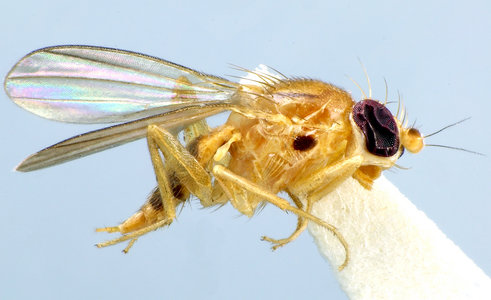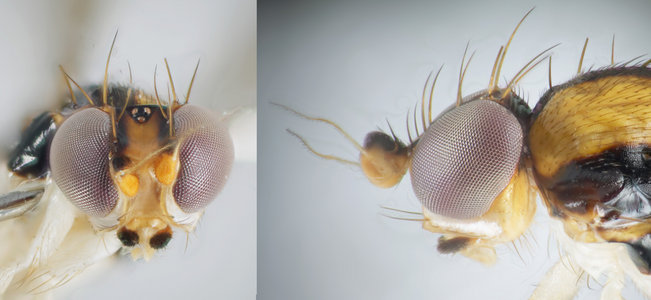Allometopon
Owen Lonsdale and Steve MarshallIntroduction
Allometopon Kertesz is a relatively uncommon genus most closely resembling small Sobarocephala and a few pale Hendelia, but the anterior fronto-orbital bristle is reclinate, there are no dorsal preapical tibial bristles, and the surstyli are usually larger and quite elaborately sculptured.
Allometopon is predominantly found in southeast Asia, but a few species are known from Japan, Australia and the Seychelles. The biology and preferred habitat of this genus are unknown. There are 15 described species in the genus, but there are also numerous undescribed species that occur throughout the Indoaustralian Region (Lonsdale & Marshall, in manuscript). Because of its ambiguous basal position in the Clusiodinae, establishing the phylogeny of Allometopon will be essential to our understanding of the evolution of the Clusiidae.


Habitus of Allometopon sp. © Steve Marshall
Characteristics
Allometopon is smaller than most clusiids (often being less than 4.0 mm in length), and is predominantly yellow with a variable brown pattern, although some species have evolved a predominantly brown notum. Externally, Allometopon is the only clusiid with entirely reclinate fronto-orbitals that does not have dorsal preapical tibial bristles. Many species are further characterized by other characters such as a minute pair of interfrontal bristles just above the ptilinal suture, reduced to absent postvertical bristles and a reduced anterior dorsocentral that is moved posteriorly.
Like species in the Sobarocephalinae, Allometopon has retained a relatively plesiomorphic morphology, strongly contrasting the derived condition seen in the other Clusiodinae. Allometopon is placed in the same subfamily with these derived genera, however, because it shared longitudinally segmented spermathecae, no ventrolateral lobes on the hypandrium, entirely reclinate fronto-orbitals (reversed in Heteromeringia Czerny and Tranomeringia Sasakawa), and no presutural intra-alar bristle (recovered in some Czernyola).
References
Lonsdale, O. & Marshall, S.A. 2006. Redefinition of the Clusiinae and Clusiodinae, description of the new subfamily Sobarocephalinae, revision of the genus Chaetoclusia and a description of Procerosoma gen. n. (Diptera: Clusiidae). European Journal of Entomology, 103: 163-182.
Title Illustrations

| Scientific Name | Allometopon sp. |
|---|---|
| Specimen Condition | Dead Specimen |
| Identified By | O. Lonsdale |
| Sex | Male |
| Life Cycle Stage | Adult |
| Image Use |
 This media file is licensed under the Creative Commons Attribution-NonCommercial License - Version 3.0. This media file is licensed under the Creative Commons Attribution-NonCommercial License - Version 3.0.
|
| Copyright |
© Owen Lonsdale

|
About This Page
Owen Lonsdale

Canadian National Collection of Insects, Arachnids & Nematodes
Steve Marshall

University of Guelph, Canada
Correspondence regarding this page should be directed to Owen Lonsdale at and Steve Marshall at
Page copyright © 2011 Owen Lonsdale and Steve Marshall
 Page: Tree of Life
Allometopon.
Authored by
Owen Lonsdale and Steve Marshall.
The TEXT of this page is licensed under the
Creative Commons Attribution-NonCommercial License - Version 3.0. Note that images and other media
featured on this page are each governed by their own license, and they may or may not be available
for reuse. Click on an image or a media link to access the media data window, which provides the
relevant licensing information. For the general terms and conditions of ToL material reuse and
redistribution, please see the Tree of Life Copyright
Policies.
Page: Tree of Life
Allometopon.
Authored by
Owen Lonsdale and Steve Marshall.
The TEXT of this page is licensed under the
Creative Commons Attribution-NonCommercial License - Version 3.0. Note that images and other media
featured on this page are each governed by their own license, and they may or may not be available
for reuse. Click on an image or a media link to access the media data window, which provides the
relevant licensing information. For the general terms and conditions of ToL material reuse and
redistribution, please see the Tree of Life Copyright
Policies.
- First online 25 August 2005
- Content changed 20 August 2007
Citing this page:
Lonsdale, Owen and Steve Marshall. 2007. Allometopon. Version 20 August 2007 (under construction). http://tolweb.org/Allometopon/27680/2007.08.20 in The Tree of Life Web Project, http://tolweb.org/








 Go to quick links
Go to quick search
Go to navigation for this section of the ToL site
Go to detailed links for the ToL site
Go to quick links
Go to quick search
Go to navigation for this section of the ToL site
Go to detailed links for the ToL site